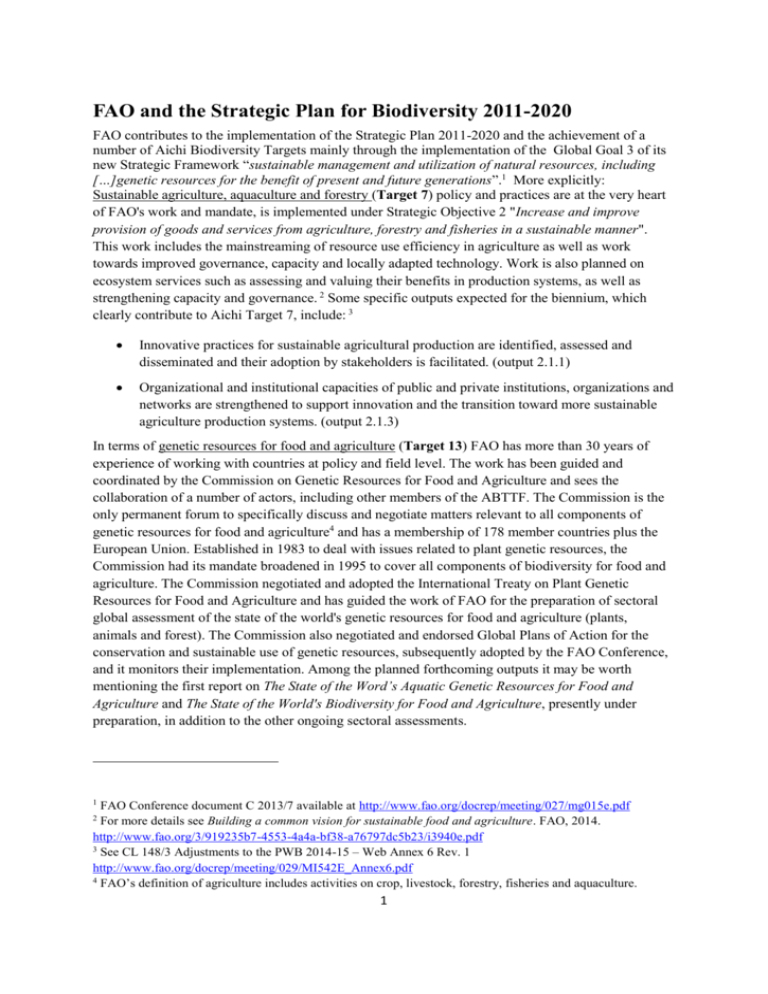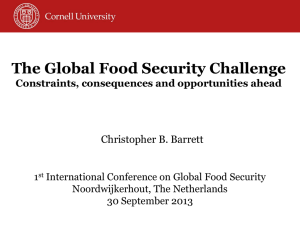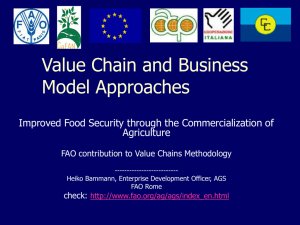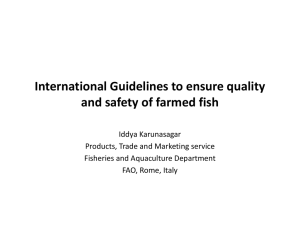FAO and the Strategic Plan for Biodiversity 2011-2020
advertisement

FAO and the Strategic Plan for Biodiversity 2011-2020 FAO contributes to the implementation of the Strategic Plan 2011-2020 and the achievement of a number of Aichi Biodiversity Targets mainly through the implementation of the Global Goal 3 of its new Strategic Framework “sustainable management and utilization of natural resources, including […]genetic resources for the benefit of present and future generations”.1 More explicitly: Sustainable agriculture, aquaculture and forestry (Target 7) policy and practices are at the very heart of FAO's work and mandate, is implemented under Strategic Objective 2 "Increase and improve provision of goods and services from agriculture, forestry and fisheries in a sustainable manner". This work includes the mainstreaming of resource use efficiency in agriculture as well as work towards improved governance, capacity and locally adapted technology. Work is also planned on ecosystem services such as assessing and valuing their benefits in production systems, as well as strengthening capacity and governance. 2 Some specific outputs expected for the biennium, which clearly contribute to Aichi Target 7, include: 3 Innovative practices for sustainable agricultural production are identified, assessed and disseminated and their adoption by stakeholders is facilitated. (output 2.1.1) Organizational and institutional capacities of public and private institutions, organizations and networks are strengthened to support innovation and the transition toward more sustainable agriculture production systems. (output 2.1.3) In terms of genetic resources for food and agriculture (Target 13) FAO has more than 30 years of experience of working with countries at policy and field level. The work has been guided and coordinated by the Commission on Genetic Resources for Food and Agriculture and sees the collaboration of a number of actors, including other members of the ABTTF. The Commission is the only permanent forum to specifically discuss and negotiate matters relevant to all components of genetic resources for food and agriculture4 and has a membership of 178 member countries plus the European Union. Established in 1983 to deal with issues related to plant genetic resources, the Commission had its mandate broadened in 1995 to cover all components of biodiversity for food and agriculture. The Commission negotiated and adopted the International Treaty on Plant Genetic Resources for Food and Agriculture and has guided the work of FAO for the preparation of sectoral global assessment of the state of the world's genetic resources for food and agriculture (plants, animals and forest). The Commission also negotiated and endorsed Global Plans of Action for the conservation and sustainable use of genetic resources, subsequently adopted by the FAO Conference, and it monitors their implementation. Among the planned forthcoming outputs it may be worth mentioning the first report on The State of the Word’s Aquatic Genetic Resources for Food and Agriculture and The State of the World's Biodiversity for Food and Agriculture, presently under preparation, in addition to the other ongoing sectoral assessments. 1 FAO Conference document C 2013/7 available at http://www.fao.org/docrep/meeting/027/mg015e.pdf For more details see Building a common vision for sustainable food and agriculture. FAO, 2014. http://www.fao.org/3/919235b7-4553-4a4a-bf38-a76797dc5b23/i3940e.pdf 3 See CL 148/3 Adjustments to the PWB 2014-15 – Web Annex 6 Rev. 1 http://www.fao.org/docrep/meeting/029/MI542E_Annex6.pdf 4 FAO’s definition of agriculture includes activities on crop, livestock, forestry, fisheries and aquaculture. 2 1 FAO also contributes to other Aichi Biodiversity Targets through its work. While many more activities from different sectors could be mentioned, below is a list of few specific and most recent examples: The preparation of the Global Forest Resources Assessment (FRA) 2015 report, which will look at several variables, related to trends, such as area of forest in protected areas, forest area primarily designated for conservation of biodiversity, etc. These will contribute to targets 5, 7, 11, 14, 15 and 18. Considerable substantive work in implementing sustainable forest management both through normative and field work is contributing to target 7 including through the one forest legally binding agreement existing (International Poplar Convention). FAO’s work in evaluation and payment of environmental services is contributing to target 2. The Zero illegal deforestation challenge launched at the 2013 International Day of Forests and supported by the 22nd FAO Committee on Forestry (COFO 22) is supporting Aichi target 5, including the work conducted under UNREDD. FAO has launched the Forest and Landscape Restoration Mechanism (FLR) at COFO in June 2014, which is expected to make a major contribution to Aichi target 15 related to the restoration of degraded ecosystems. FAO has also contributed to Targets 5, 11 and 15 by collaborating closely with the CBD and co-organizing several regional capacity building workshops during 2014 on ecosystem conservation and restoration. FAO contributes directly to Targets 6 and 7 through the collection and analysis of data and trends on capture fisheries and aquaculture. The FAO is the only international body systematically collecting data on global fisheries, which places it in a unique position to identify trends in the fisheries sector. FAO collects, analyses, and disseminates statistics relating to various aspects of world fisheries such as fishery production from capture fisheries and aquaculture, production and trade of fishery commodities, apparent fish consumption, fishery fleets and employment. FAO also provides regular updates on the assessment of the state of world fish stock. The FAO also monitors and facilitates implementation of a number of binding and voluntary instruments necessary for achieving Targets 6 and 7. This includes the Code of Conduct for Responsible Fisheries and its related instruments, the Port Statement Measures Agreement and others. The Fisheries and Aquaculture Department monitors the implementation of these instruments which could be used to inform indicators for Targets 6 and 7. In addition, the majority of the FAO’s Fisheries and Aquaculture Department’s work relates to sustainable and well- managed fisheries which supports all of Target 6. This includes the mainstreaming of biodiversity through the implementation of the CCRF, the Ecosystem Approach to Fisheries and related management tools such as marine protected areas thus also contributing to Target 11. For many years the Secretariats of the IPPC and the CBD have already been collaborating on areas of mutual interest with a particular interest on the issue of Invasive Alien Species. This issue is a key focus of the Aichi Biodiversity Target 9. The two Secretariats have developed a joint work plan which is currently being reviewed and updated. Our joint work plan has always had a component focused on the management of Invasive Alien Species/ Invasive 2 Pests. We have identified areas where appropriate joint actions would be beneficial and these have been supported by our respective Governing Bodies FAO also contributes to Target 14 through a number of activities and initiatives including some work in Asia, Africa and Latin America to develop guidance on how approaches and tools can be made useful and relevant in specific agroecological contexts. Providing governance and policy guidance at country level will strengthen the management of ecosystem services through initiatives such as Payments and Incentives for Ecosystem Services, the Global Soil Partnership, the Forest and Landscape Restoration Mechanism, the Watershed Management Umbrella Programme and the Globally Important Agricultural Heritage Systems initiative. Regarding target 16, FAO’s contribution would come from 1) the International Treaty on PGRFA, a constituent element of the international regime on Access and Benefit Sharing to address plant genetic resources for food and agriculture and 2) the FAO Commission on Genetic Resources for Food and Agriculture. The International Treaty entered into force in 2004 . In 2013, FAO’s Commission on Genetic Resources for Food and Agriculture was mandated to produce Draft Elements to Facilitate Domestic Implementation of Access and Benefit-Sharing for Different Subsectors of Genetic Resources for Food and Agriculture. FAO hosting the Secretary of the Mountain Partnership is contributing to targets 1, 2, 4, 7, 9, 11, 12, 13, 14, 15, 18 and 19 in mountain areas. 3






